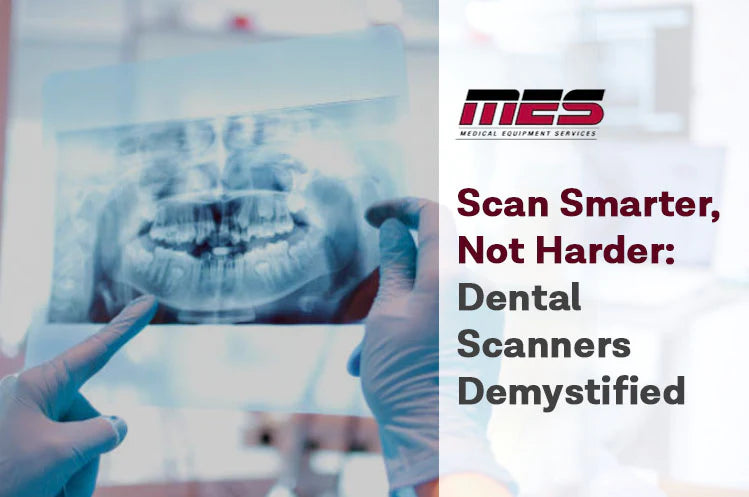Dental scanners have revolutionised the field of dentistry, offering a more efficient and accurate way to capture digital impressions, plan treatments, and fabricate dental restorations. These advanced devices are transforming the way dental professionals work, enabling them to scan smarter, not harder.
In this article, we will demystify dental scanners, exploring their evolution, types, benefits, applications, and future trends.
1. Introduction
Dental scanners are at the forefront of modern dentistry, representing a significant advancement in digital impression technology. These sophisticated devices play a crucial role in creating precise digital impressions of patients' teeth and oral structures.
By capturing detailed images of the dentition, dental scanners enable dental professionals to design and fabricate a variety of dental restorations, including crowns, bridges, and veneers, with unparalleled precision and accuracy.
The process begins with the intraoral scanner capturing digital images of the patient's teeth and surrounding oral tissues. These images are then processed by specialised software to create a digital 3D model of the patient's mouth.
This digital model serves as a virtual replica of the patient's dentition, allowing the dentist to plan and design the restoration with a high level of precision.
One of the key advantages of dental scanners is their ability to eliminate the need for traditional, messy impression materials. Instead of using impression trays and putty-like materials, which can be uncomfortable for patients, dental scanners offer a more comfortable and efficient alternative.
By streamlining the impression-taking process, dental scanners help improve patient experience and reduce chair time, benefiting both patients and dental professionals.
2. Evolution of Dental Scanners
The evolution of dental scanners can be traced back to the early 1980s when the first digital imaging systems were introduced. These systems, although rudimentary by today's standards, laid the foundation for the development of modern dental scanners.
Over the years, advancements in technology have led to the development of more advanced and accurate dental scanners.
3. Types of Dental Scanners
There are several types of dental scanners available today, each with its own set of features and benefits. The most common types include intraoral scanners, which are used to capture digital impressions inside the mouth, and extraoral scanners, which are used to scan the entire dental arch from outside the mouth.
Cone beam computed tomography (CBCT) scanners are also used in dentistry to capture detailed 3D images of the teeth and jaws.
4. How Dental Scanners Work
Dental scanners work by using various imaging technologies, such as laser, structured light, or confocal microscopy, to capture detailed images of the teeth and oral structures.
These images are then processed by software to create a digital 3D model of the patient's mouth, which can be used for treatment planning and fabrication of dental restorations.
5. Benefits of Dental Scanners
Dental scanners offer a wide range of benefits, including improved accuracy in digital impressions, enhanced patient comfort and experience, and time-saving in treatment planning and fabrication.
They also eliminate the need for messy traditional impressions, making the process more comfortable for patients.
6. Applications in Dentistry
Dental scanners are used in various areas of dentistry, including restorative dentistry, orthodontics, and implantology. In restorative dentistry, dental scanners are used to create digital impressions for crowns, bridges, and veneers.
In orthodontics, they are used for Invisalign and aligner therapy. In implantology, they are used for implant planning and placement.
7. Considerations for Choosing a Dental Scanner
When choosing a dental scanner, there are several factors to consider, including accuracy and precision requirements, compatibility with existing CAD/CAM systems, and cost. It is essential to choose a scanner that meets your practice's specific needs and budget.
8. Future Trends in Dental Scanners
The future of dental scanners looks promising, with advancements in technology driving innovation. Integration with artificial intelligence (AI) for automated analysis, miniaturisation and portability for wider adoption, and enhanced data security and patient privacy measures are some of the future trends we can expect to see in dental scanners.
9. Case Studies
Real-world examples of practices benefiting from dental scanners can provide valuable insights into their effectiveness and impact on patient care. Testimonials from clinicians and patients can also help showcase the benefits of these advanced devices.
10. Final Thoughts
In conclusion, dental scanners are revolutionising the field of dentistry, offering a more efficient and accurate way to capture digital impressions, plan treatments, and fabricate dental restorations. By embracing this technology, dental professionals can scan smarter, not harder, enhancing patient care and practice efficiency.
Overall, dental scanners are a crucial tool in modern dentistry, offering numerous benefits and applications. Their evolution has significantly improved the accuracy and efficiency of dental procedures, making them an essential investment for dental practices looking to enhance patient care and streamline their workflow.
At MES Australia, we understand the significance of providing state-of-the-art dental equipment that meets the evolving needs of dental practices. With over 60 years of experience, we take pride in being a trusted supplier of high-quality dental chairs and equipment in Australia.
For all your medical and dental supply requirements, please call us today on 1300 342 013 or leave an enquiry.


